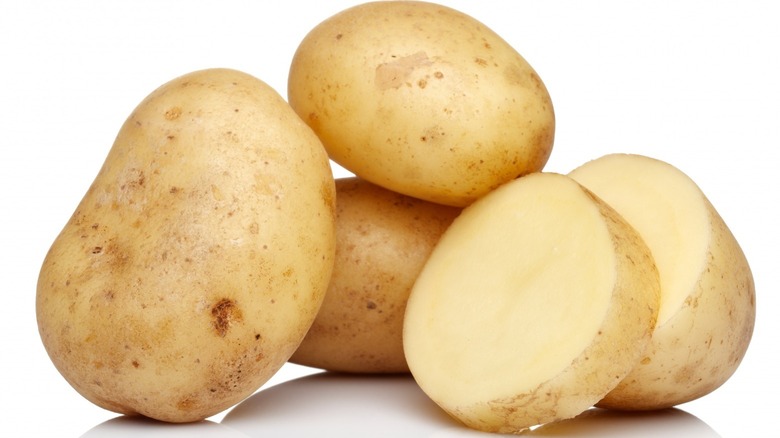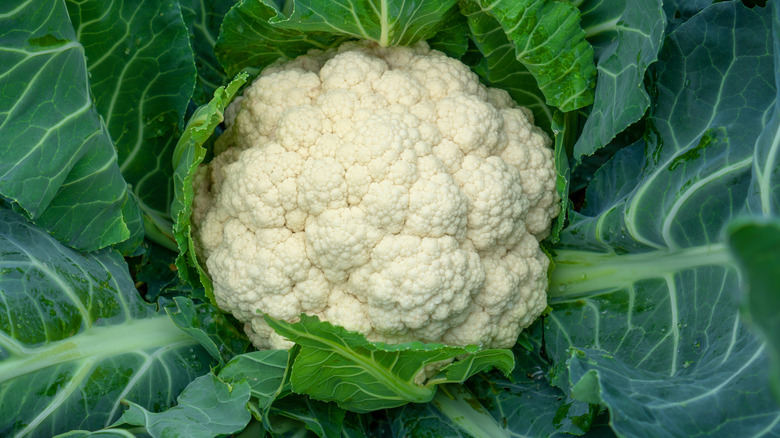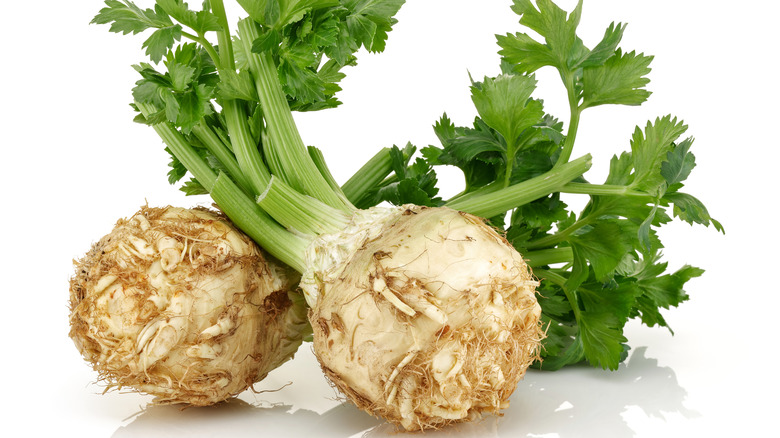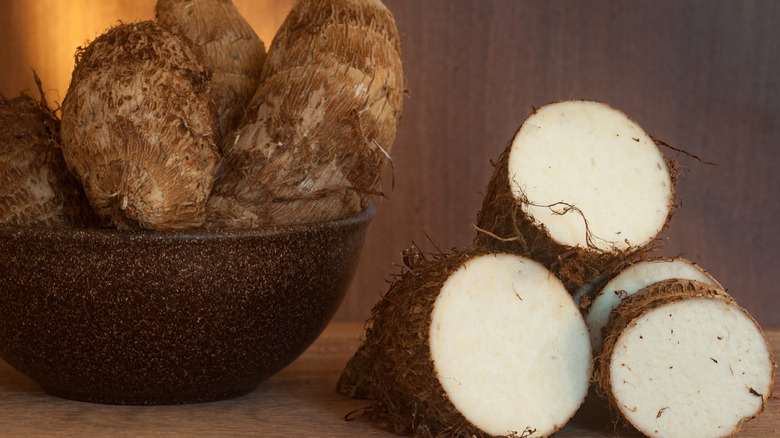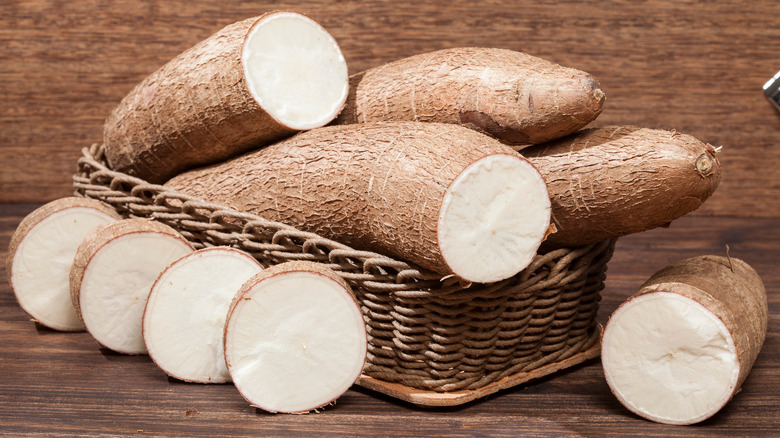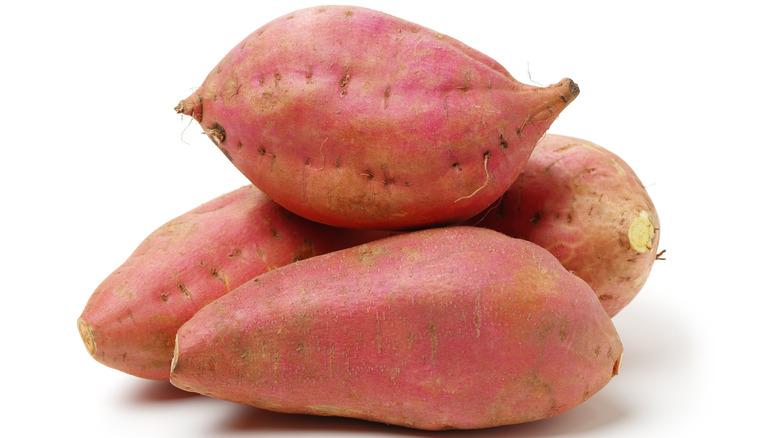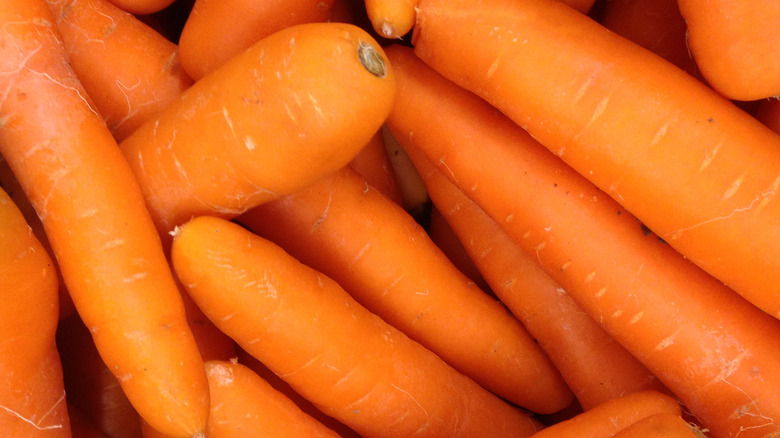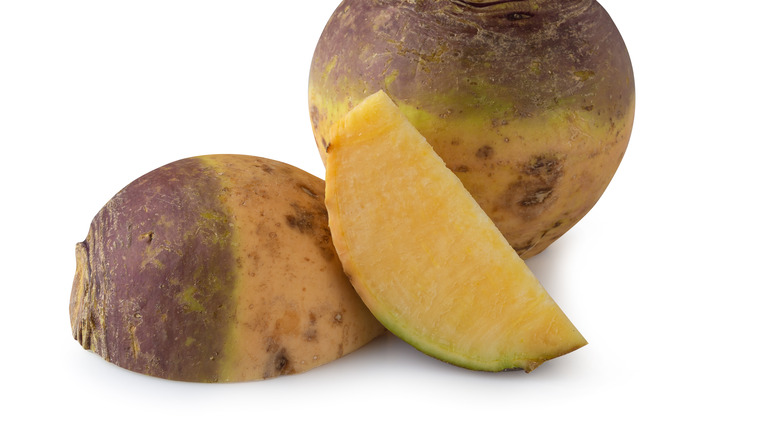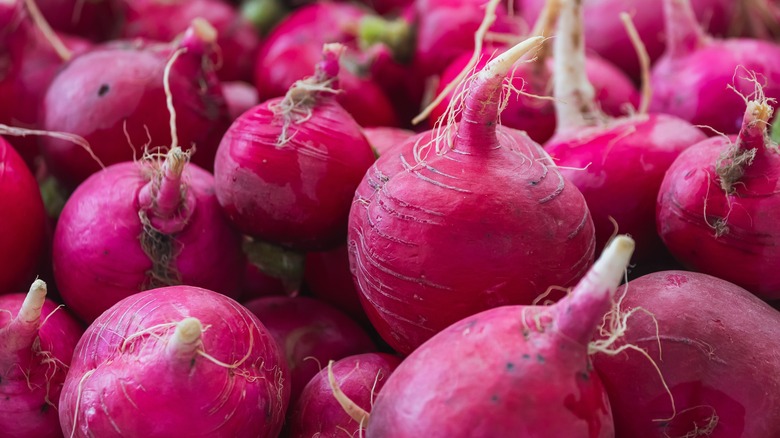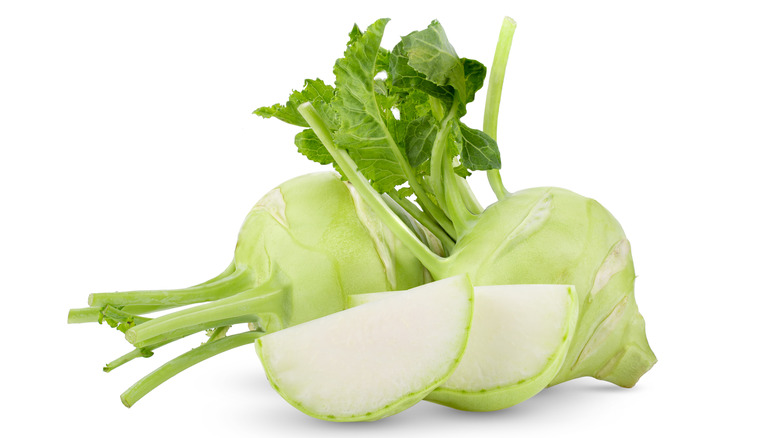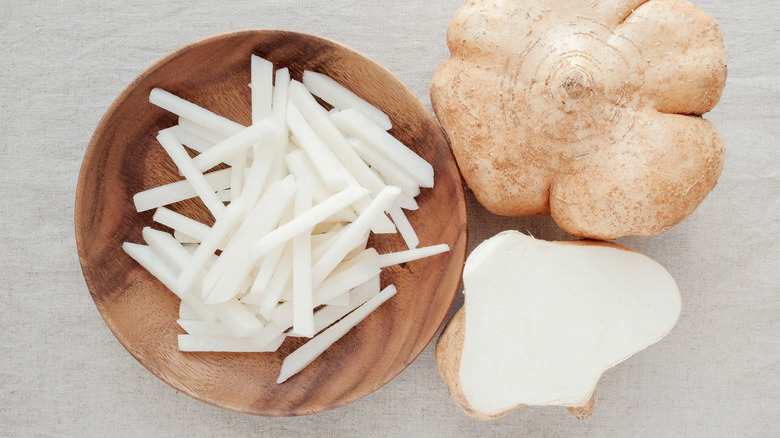10 Best Substitutes For Potatoes
The potato is the earliest domesticated vegetable known to man and was a prominent food source throughout history, sometimes without the option of a substitute.
The root vegetable originated 8000 years ago in the regions of current-day Bolivia and Peru, per BBC. Since then, it spread and featured in some of history's landmarks, like when Frederick the Great forced it on peasants in the early 1700s, per The Lit and Phil. Queen Marie Antoinette is known to have started a trend in fashion circles when she wore potato blossoms in her hair, per Nobility, and made history again when it became the first vegetable cultivated in space, per AndNowUKnow. Today, 125 countries produce potatoes, as well as all 50 states in the U.S., per Idaho Potato Museum, cultivate the vegetable to feed the average American, who eats up to 124 pounds of potatoes yearly.
According to the Carnegie Museum of Natural History, potatoes belong to the nightshade family and contain vitamin C, B6, manganese, phosphorus, niacin, and pantothenic acid, which all assist with body functions, per Livescience. Be that as it may, this popular all-purpose vegetable is relatively high in carbs and calories that lead to sugar spikes, per Better Nutrition. Should this drive you to replace your potato recipes, you will not be the first: people have been substituting it for a while, making it easier for us to find ten healthy replacements for the world's first domesticated vegetable.
10. Cauliflower
When looking for a potato substitute, cauliflower is probably among the last vegetables we would imagine. Nonetheless, it is a viable replacement for the starchy tuber and although it has fewer carbs (5g per 100g serving, per Michigan State University), it is highly nutritious, more so than potatoes, in fact.
According to The United States Department of Agriculture (via Livestrong), cauliflower contains 2.1g fiber, 2.05g protein, 5.32 grams of carbs, and 27 calories per 100g serving. Livestrong also emphasizes its abundance of vitamin C, folate, and choline, which, as per WebMD, is important for liver health, metabolism, and nervous system functions. Additionally, cauliflower contains no fat, and its nutrient makeup helps combat cell damage (and ultimately cancer).
Cauliflower as a substitute for potato, according to The Daily Meal, leaves nothing to be desired, whether it is in the form of Pokhara, mashed cauliflower, or as a gratin. These cauliflower dishes, perfected, may pass off as potatoes.
9. Celery root
Celery root, aka celeriac, though a member of the celery family, is not just the root of a celery plant, per Medical News Today. Unlike the actual celery plant, celeriac is cultivated specifically for its roots. Its taste, as per Cooks Illustrated, is "mild and celery-like and sweetens with cooking". As eloquent as that sounds, celeriac will win no points for looks with its oversized and wrinkled radish-like shape.
Per cup (or per 100g), this vegetable contains 14g of carbs, 2.8g fiber, 2.3g fat, 66 calories, and the same amount of protein as potatoes. It has a relatively high sodium content (156mg) compared to potatoes (4.5mg), per Verywell Fit, University of Rochester Medical Center. Celeriac also has high quantities of magnesium, calcium, and phosphorus, per The United States Department of Agriculture, which are crucial electrolytes for the body's daily functions.
Celeriac can work as a replacement for potatoes in stews, as chips after cutting it into slices and roasting it, or even as mash after boiling it and then blending it, per Delishably.
8. Yam
The yam comes from the lily family, and yes, it doesn't look anything like a lily, but that is because it is a tuber from the plant's root system. Although it is commonly (and mistakenly) referred to as sweet potatoes, yams are vegetables in their own class, per The Spruce Eats. An article on The Library of Congress website credits the name of this particular tuber to Africans during the American slave era. They referred to it by this name because it was reminiscent of food they ate back home.
Yams have relatively soft textures and are sweeter than potatoes; with a bit of cinnamon and butter, they become a suitable diabetic snack, per San Francisco Gate.
Yams contain more dietary fiber (6g) than the white potato (3.5g), and aside from its other nutritional attributes (carbs, 42g; protein, 2.5g; and its richness in potassium and B vitamins). They also have a lower glycemic index (37), as per San Francisco Gate.
Baked yam fries are a healthier alternative to the standard potato french fries, according to The Healthy, and will also suffice in mashed form.
7. Cassava
Though not related to the white potato, the taste of cassava is similar, and its uses are almost as expansive. According to We Seed Exchange, the cassava plant is a hardy tuber that originated in South America. This root vegetable was domesticated approximately 10 000 years ago and started proliferating around the same period.
According to Healthline, cassava can be ground into flour and then used to make gluten-free bread, tapioca, and alcoholic beverages, among other things, per Britannica. The proteins and fiber in potatoes outweigh that in cassava, but cassava has more Vitamin B2, E, A, and Folate. The tuber's Vitamin E content dwarfs that of potatoes, per Foodstruct, while neither have Vitamin D or B12. When cooking with cassava, it is vital to remember that in its raw form, it contains harmful quantities of cyanide that can be detrimental to humans. The correct way to prepare cassava is to peel and chop the root into small cubes, soak it and boil it until soft. This process renders any harmful chemicals in the vegetable harmless, provided that you throw out the remaining water after use, per Medical News Today.
Cassava chips are an appropriate substitute for potato fries, but the preparation process tends to be labor-intensive. It requires peeling and the previously mentioned soaking and boiling before carving out some rather rustic-looking thick chips and deep-frying them, per The Guardian. Cassava also makes a mean mash potato substitute, as per The Spruce Eats.
6. Sweet potatoes
Just because of its name, it does not mean that sweet potato contains a high percentage of sugar, per San Francisco Gate, or that it belongs to the potato family.
Sweet potatoes have more dietary fiber than white potatoes and a surprisingly lower glycemic index despite their taste. They contain similar quantities of carbohydrates, proteins, minerals, and vitamins, but where they differ is sweet potato contains up to 107% of vitamin A in its recommended daily value, and white potatoes contain almost nothing, per Healthline.
Additionally, sweet potatoes also contain mannitol. In large concentrated quantities, this compound is considered unhealthy, per Well Curve. In natural quantities, it detoxes the body and prevents the impurities from filtering back into the body as they work their way out, per Drugbank. Sweet potato's natural sweetness makes it ideal for type 2 diabetics and interchangeable with any dish where white potato features, including the topping on a shepherd's pie, per BBC Good Food.
5. Carrots
Did you know that carrots actually originated in Afghanistan about 900 AD? Around that period, they were purple, white, and yellow, per The Economist. The color we know appeared only around the 15th century, per Web MD.
Unlike potatoes, the carrot is a true root, per Calories Info, with fewer carbs (9.58 g) and calories (41) but more fat. It also has a higher percentage of dietary fiber (2.8g) and less protein (0.93g) per 100g. Eating ten or more carrots a day could have side effects. According to a study by Hess and Meyers (via The National Library of Medicine), the daily consumption of too many carrots has previously caused a yellowish-orange skin discoloration.
While carrots may be an unsuspecting substitute for potatoes, the same cooking methods apply to carrots with fair (if not better) results. Carrots can be roasted, mashed, cut, fried like french fries, and even pureed, per Jamie Geller.
4. Rutabaga
What is the rutabaga? This root vegetable is a slightly oviform, thick-skinned bulb that appears like a cross between a cabbage and a turnip. It first turned up around 1300-1500 AD in Northern and Eastern Europe, per Britannica. It is generally white with a purple hue around the bottom of the bulb.
It is a low-carb alternative to potatoes which contains 108% more calories, 103% more carbs, and 90% more proteins, per Calories Info. Rutabaga, on the other hand, has 60% more fat and 10% more fiber than potatoes. It contains potassium, magnesium, calcium, and a high percentage of Vitamin C, which in concert with Vitamin E, serve as antioxidants, per Healthline.
While you can easily shape and cook them like fries, the taste and texture of rutabaga will remind you of what they are not. They have a rich flavor with a bitter edge even after being cooked but be that as it may, they are still a fair substitute for the white potato original, Feel Good Foodie. They can also be roasted like potato chips or mashed, according to Food Network, and even edible in a raw state.
3. Radishes
The Romans and Greeks identified healing and preventative qualities in radish 2500 years ago, per Web MD, and today radishes are believed to have a detoxification value and avert cancer in the digestive tracts and the organs of humans, per Healthline, Springer. They contain catechin, pyrogallol, vanillic acid, and a fair amount of Vitamin C, making them a potent source of antioxidants.
The amount of fat in radishes and potatoes is equal, but dietary fiber (31%) and proteins (201%) are more in potatoes. Potatoes contain 381% more calories than radishes and an astounding 414% more carbs, per Calories Info. This then makes radishes the obvious choice for a low-carb diet.
Radish, when cooked, becomes similar to potatoes in taste and even loses most of its distinctive flavor, per Rare Breed Farms. As such, they make a formidable substitute for roasted ranch potatoes, and with a bit of boiling, blending, and cornstarch, they will make a convincing replacement for mashed potatoes.
2. Kohlrabi
If the word kohlrabi has to be translated directly into English, it would mean "cabbage-turnip", and given its appearance, we understand how the Germans arrived at the name. According to Aggie Horticulture, it is a descendant of wild cabbage and dates back to 16th century Europe. It tastes like cabbage (a bit like broccoli) but is slightly sweeter, per Healthline.
The kohlrabi plant possesses more or less the same amount of nutrition but fewer carbohydrates (4.77%), more dietary fiber and more (9.47%), and its vitamin C percentage of 69%, dwarfing that of potatoes (14%), per Vegan Nutrition Tracker. Additionally, kohlrabi has 185% fewer calories than potatoes, per Calories Info. Because of its nutritional makeup it assists with the metabolism, minimizes the chance of birthing complications, boosts immunity, and supports weight loss, per Web MD.
According to The Spruce Eats, there are a few different ways to prepare the potato substitute, including roasting and steaming, and this is aside for purees, soups, and salads.
1. Jicama Root
The jicama root comes from the nightshade family and is the closest vegetable to a potato, per San Francisco Gate. Jicamas are brown, large, and can weigh up to 50 pounds. It has a thin skin and a starchy texture with a flavor that is said to be close to that of apples without being sweet, per Web MD. Today it is cultivated in the United States, Central America, and North America, per Very Well.
Jicama root has fewer calories than potatoes and a high vitamin C content that gives it the antioxidant quality of some potato substitutes, per Medical News Today. Jicama stimulates the immune system, helps build strong bones, and is also an anti-inflammatory.
According to Baptist Health, jicama is eaten in the place of mashed potato, cooked as fries, and is safe to consume raw. As close as it is to white potato, it can never be as soft, so one should be careful not to overcook it.
